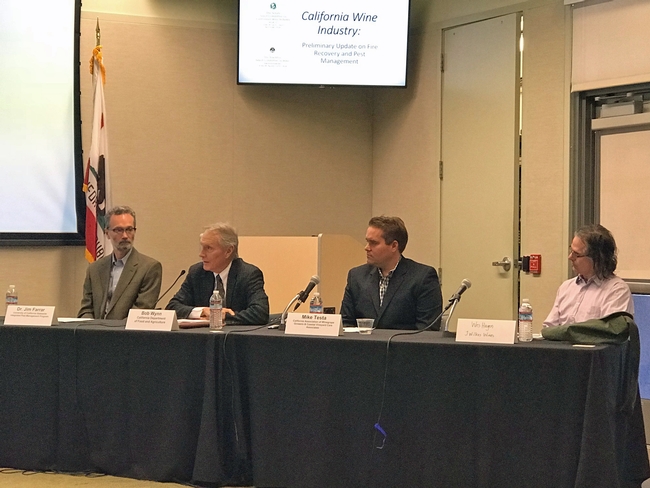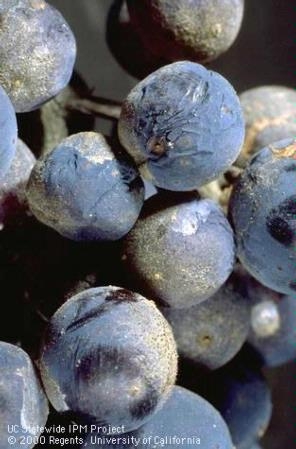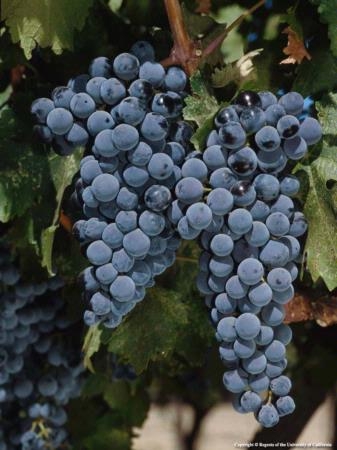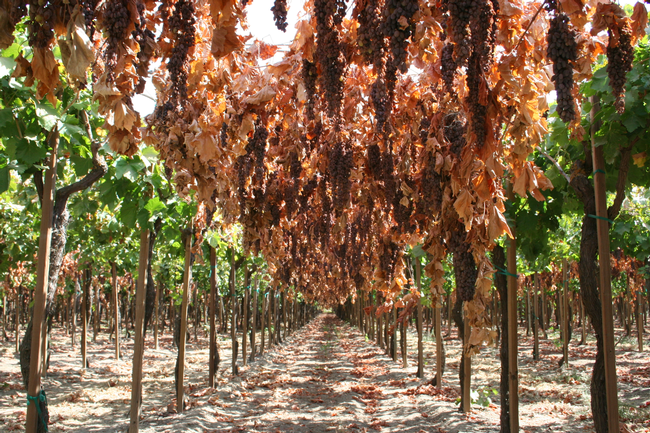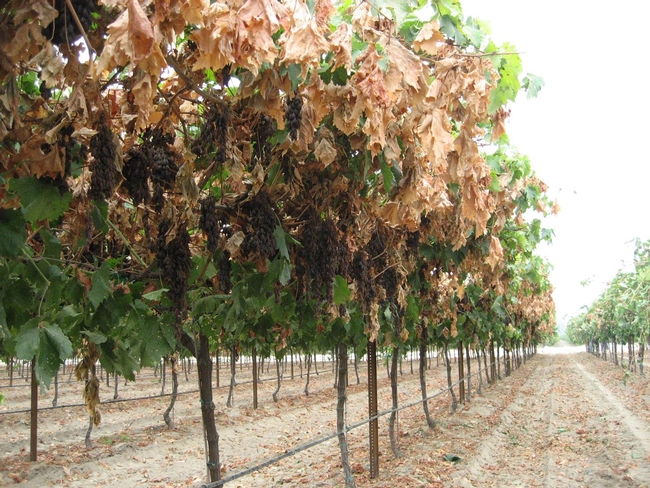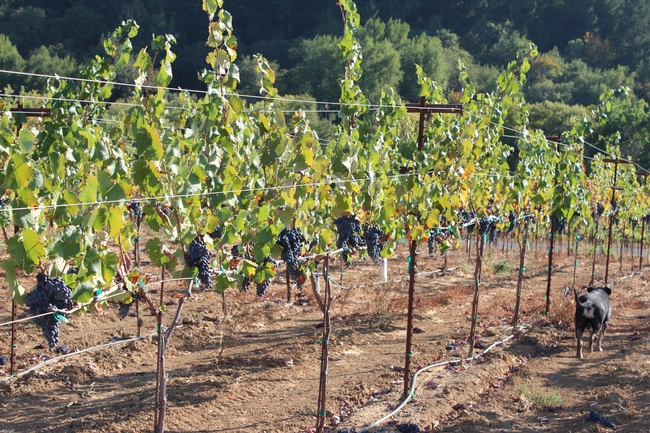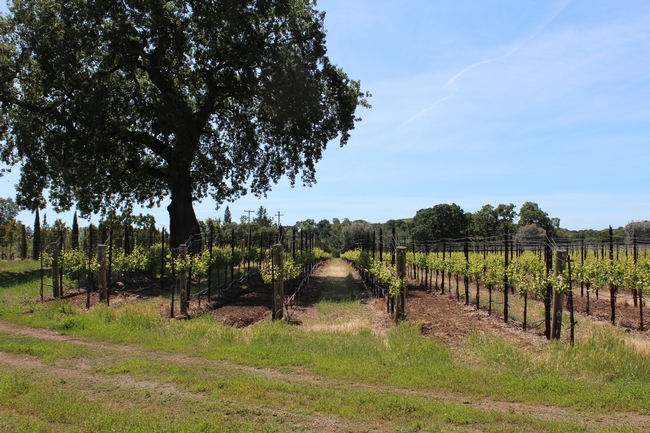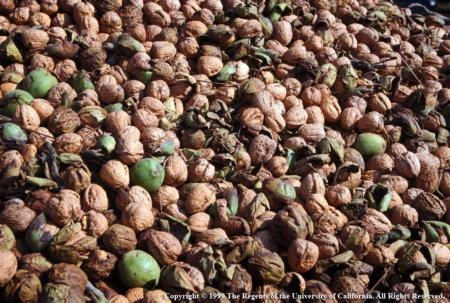Posts Tagged: Grapes
UC IPM’s Farrar briefs legislators on threats to California winegrapes
Recent surveys in the North Coast have found that 90 percent of the powdery mildew samples collected were resistant to strobulurin fungicides, the director of UC Integrated Pest Management Program told legislators at a joint hearing of the California Assembly and Senate Select Committees on California's Wine Industry. A potential solution is breeding winegrapes to be resistant to powdery mildew, but a drawback is that the wine industry is largely known for its varietals.
“Professor Andy Walker at UC Davis has succeeded in crossing winegrapes with a wild grape species that is naturally resistant to powdery mildew and then crossing the offspring back to the parent winegrape variety for several generations,” said James Farrar, who was invited to speak at the committees' informational hearing on “Fire Recovery and Pest Management Awareness” at UC Santa Barbara on Nov. 7.
In addition to powdery mildew, he also talked about red blotch virus, which was relatively recently identified in California, and grapevine leafroll associated virus and the mealybug species that transmit the virus. Bob Wynn from the California Department of Food and Agriculture gave an update on Pierce's disease and its vector glassy-winged sharpshooter.
Farrar warned the legislators of increased human health risks due to “unintended consequences of social pressure” on the herbicide glyphosate, which growers use to control weeds under grapevines rather than tilling the soil, to comply with Natural Resources Conservation Service and Salmon Safe guidelines.
“Recent social pressure resulting from the International Agency for Research on Cancer labeling glyphosate a probable human carcinogen and news stories indicating detection of glyphosate in wine have caused some growers to look at other herbicides,” Farrar said. “The other choices are glufosinate, which is more risky to applicators, less effective, and more expensive, and paraquat, which has similar price and effectiveness, but much greater risk to applicators. Paraquat is a restricted-use pesticide that is highly toxic to humans – 3 teaspoons will kill an adult. It has a higher risk ‘Danger' label in contrast to the lower risk ‘Caution' label for glyphosate.
“This is an increased risk to human health as a result of misplaced public perception of risk.”
Farrar closed his comments by saying, “The County Agricultural Commissioners and county-based University of California Cooperative Extension advisors are vital in the continued efforts to manage winegrape pests and diseases. They are the frontline support for growers and pest control advisers in this effort.”
To read the full transcript of Farrar's comments, visit http://ucanr.edu/files/273433.pdf. His handouts on grape pest management are at http://ucanr.edu/files/273434.pdf.
UC releases new cost study for growing winegrapes
UC Agricultural Issues Center has released a new study on the cost and returns of establishing a vineyard and producing winegrapes in the northern San Joaquin Valley.
The cultural practices described represent the establishment and production operations, as well as materials of a well-managed cabernet sauvignon vineyard in this region. The costs, materials, and practices shown in this study will not apply to all farms. Growers, UC ANR Cooperative Extension farm advisors, and other agricultural associates provided input and reviewed the methods and findings of the study.
The hypothetical 200-contiguous-acre farm is located in Crush District 11, which includes San Joaquin and Sacramento counties. The economic life of the grower-owned-and-operated cabernet sauvignon vineyard used in this cost analysis is 25 years. Vine management includes hand operations such as pruning, suckering, shoot removal and positioning. The grapevines are mechanically trimmed and harvested. This study does not include cluster thinning, but other winegrape varieties may require thinning due to compactness.
The authors describe the assumptions used to identify current costs for establishment and production of the winegrapes, material inputs, cash and non-cash overhead. Ranging analysis tables show profits over a range of prices and yields. Other tables show the monthly cash costs, the costs and returns per acre, hourly equipment costs, and the whole farm annual equipment, investment and business overhead costs.
The new study is titled “Sample Costs to Establish a Vineyard and Produce Winegrapes- Cabernet Sauvignon Variety, San Joaquin Valley North, San Joaquin and Sacramento Counties – 2016.”
Free copies of this study and sample cost-of-production studies for many other commodities are available. To download the cost studies, visit the UC Davis Department of Agricultural and Resource Economics website at http://coststudies.ucdavis.edu.
The cost and returns program is funded by the UC Agricultural Issues Center, which is part of UC Division of Agriculture and Natural Resources, and the UC Davis Department of Agricultural and Resource Economics.
For additional information or an explanation of the calculations used in the studies, contact Jeremy Murdock at the Agricultural Issues Center at (530) 752-4651 or jmmurdock@ucdavis.edu or UC Cooperative Extension San Joaquin County farm advisor Paul Verdegaal at psverdegaal@ucanr.edu.
UC releases new cost studies for growing plums and raisins in the San Joaquin Valley
UC Agricultural Issues Center has released three new studies, one on the cost and returns of establishing an orchard and producing fresh market plums, and the cost and returns of establishment and production of dried-on-vine (DOV) raisins under two different trellis systems.
The cost and returns are multi-year studies based on hypothetical farm operations of well-managed orchards and vineyards, using practices common to the San Joaquin Valley. Growers, UC ANR Cooperative Extension farm advisors and other agricultural associates provided input and reviewed the methods and findings of the studies.
The plum study, using double-line drip irrigation, estimates costs from orchard establishment through the production years. The economic life of the orchard used in this cost analysis is 18 years.
The DOV raisin establishment and production cost studies are under different trellis systems; overhead trellis system (OHTS) and open gable trellis system (OGTS). The two separate DOV raisin studies use single-line drip irrigation. The economic life of the vineyards used in these cost analysis is 30 years.
The authors describe the assumptions used to identify current costs for each crop, material inputs, cash and non-cash overhead. A ranging analysis table shows net returns over a range of prices and yields. Other tables show the monthly cash costs, the costs and returns per acre, hourly equipment costs, and the whole farm annual equipment, investment and business overhead costs.
The new studies are titled:
- Sample Costs to Establish an Orchard and Produce Fresh Market Plums in the San Joaquin Valley – South- 2016
- Sample Costs to Establish a Vineyard and Produce DOV Raisins (OGTS) in the San Joaquin Valley - 2016
- Sample Costs to Establish a Vineyard and Produce DOV Raisins (OHTS) in the San Joaquin Valley - 2016
Free copies of these studies and other sample cost of production studies for many commodities are available online. To download the cost studies, visit the UC Agricultural Issues Center Cost Studies website at http://coststudies.ucdavis.edu.
The cost and returns program is funded by the UC Agricultural Issues Center, which is part of UC Division of Agriculture and Natural Resources, and the UC Davis Department of Agricultural and Resource Economics.
For additional information or an explanation of the calculations used in the studies, contact Donald Stewart through the UC Agricultural Issues Center at (530) 752-4651 or destewart@ucdavis.edu. Contact UC Cooperative Extension advisors through the local UCCE office http://ucanr.edu/County_Offices
UC releases new cost study for growing winegrapes in North Coast
A new study on the cost and returns of producing winegrapes in the North Coast region's Russian River Valley, an American Viticulture Area in Sonoma County, has been released by the UC Agricultural Issues Center and the UC Davis Department of Agricultural and Resource Economics.
The cultural practices described represent production operations and materials of a well-managed vineyard in this region. The costs, materials and practices shown in this study will not apply to all farms. The production focuses on two varieties, chardonnay and pinot noir. Growers, UC Cooperative Extension farm advisors and other agricultural associates provided input and reviewed the methods and findings of the study.
The authors describe the assumptions used to identify current costs for production of the winegrapes, material inputs, cash and non-cash overhead. Ranging analysis tables show profits over a range of prices and yields for each variety. Other tables show the monthly cash costs, the costs and returns per acre, hourly equipment costs, and the whole farm annual equipment, investment and business overhead costs.
The new study is titled “Sample Costs to Produce Winegrapes, Chardonnay and Pinot noir, North Coast Region Russian River Valley, Sonoma County – 2016.”
Free copies of this study and other sample cost of production studies for many commodities are available. To download the cost studies, visit the UC Davis Department of Agricultural and Resource Economics website at http://coststudies.ucdavis.edu.
The cost and returns program is funded by the UC Agricultural Issues Center, which is part of UC Division of Agriculture and Natural Resources, and the UC Davis Department of Agricultural and Resource Economics.
For additional information or an explanation of the calculations used in the studies, contact the Agricultural Issues Center at (530) 752-4651, Donald Stewart at destewart@ucdavis.edu or Rhonda Smith, UC Cooperative Extension advisor in Sonoma County, at (707) 565-2621 or rhsmith@ucanr.edu.
UC estimates production costs for walnuts, wine grapes, hay, blackeye beans
New studies showing production costs for conventionally and organically grown walnuts, organic alfalfa hay, wine grapes and single- and double-cropped blackeye beans are now available from the University of California Cooperative Extension.
Each analysis is based upon hypothetical farm operations using practices common in the region. Input and reviews were provided by UC Cooperative Extension farm advisors, researchers, growers, farm accountants, pest control advisers, consultants and other agricultural associates.
Each report describes the assumptions used to identify current costs for the individual crops, material inputs, cash and non-cash overhead. A ranging analysis table shows profits over a range of prices and yields. Other tables show the monthly cash costs, the costs and returns per acre, hourly equipment costs, and the whole farm annual equipment, investment and business overhead costs.
The six new cost studies are the following:
- Sample Costs to Produce Organic Walnuts, 2013, North Coast by Rachel B. Elkins, Karen M. Klonsky and Richard L. De Moura.
- Sample Costs to Produce Organic Alfalfa Hay, 2013, California by Rachael F. Long, Steve B. Orloff, Karen M. Klonsky and Richard L. De Moura.
- Sample Costs to Establish and Produce Walnuts, 2013, Northern San Joaquin Valley by Joseph A. Grant, Janet L. Caprile, David A. Doll, Kathleen Kelly Anderson, Karen M. Klonsky and Richard L. De Moura.
- Sample Costs to Establish and Produce Wine Grapes, 2013, Sacramento Valley by Chuck A. Ingels, Karen M. Klonsky and Richard L. De Moura.
- Sample Costs to Produce Blackeye Beans (double-cropped), 2013, Southern San Joaquin Valley and Sample Costs to Produce Blackeye Beans (single-cropped), 2013, Southern San Joaquin Valley by Carol A. Frate, Karen M. Klonsky and Richard L. De Moura.
The cost of production studies for these and other crops are available online at http://coststudies.ucdavis.edu, at UC Cooperative Extension offices or by calling (530) 752-3589.
For additional information about the studies, contact Richard De Moura at rdemoura@ucdavis.edu.

